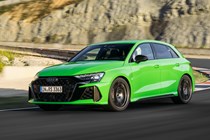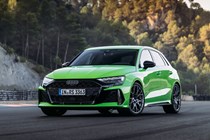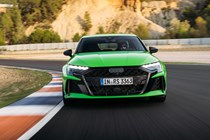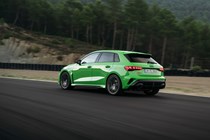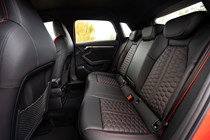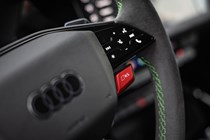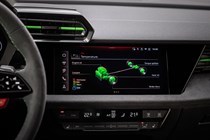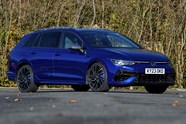Audi A3 RS 3 Sportback review

At a glance
| Price new | £61,190 - £70,330 |
|---|---|
| Used prices | £35,050 - £58,986 |
| Road tax cost | £620 |
| Insurance group | 35 - 40 |
Get an insurance quote with

|
|
| Fuel economy | 30.1 - 31.4 mpg |
| Miles per pound | 4.4 - 4.6 |
| Number of doors | 5 |
| View full specs for a specific version | |
Available fuel types
Petrol
Pros & cons
- Great engine – powerful and sounds charismatic
- Agile and surprisingly comfortable
- High-quality interior
- Expensive to buy, pricey options
- Irritating steering wheel buttons
- Driving modes can be confusing
Audi A3 RS 3 Sportback rivals
Overview
Audi’s RS3 has always sat at the most expensive end of the hot hatch spectrum, but it’s been able to justify its price with its high-end interior and cool five-cylinder engine that harks back to the firm’s ’80s rallying days.
Audi has retained that powertrain since 2011, upping the power over the years but retaining the engine’s evocative soundtrack. Despite the RS3’s high price – these days it starts from almost £60,000 – it’s proven popular, with 80,000 sold since its initial introduction.
The third-generation model launched in 2021, and is available as both a compact saloon and five-door hatchback, with its core rival being the Mercedes-AMG A45 S, while you could also consider a Volkswagen Golf R or a BMW M135. We highly rate the front-wheel-drive Honda Civic Type R, too.
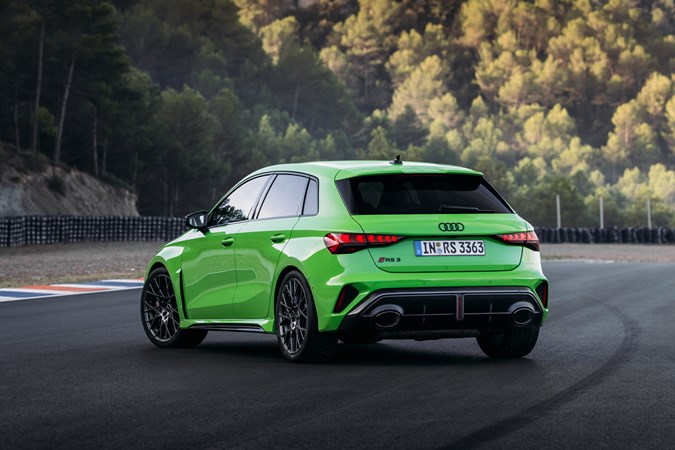
Audi updated its standard A3 and sportier S3 in 2024 and now it’s the turn of the tip-top RS3. Its engine has been left as it was, thankfully, but now has a sportier exhaust that makes more noise from lower revs. Changes have also been made to its differential, which is able to send the torque (pulling power) to the wheel on the outside of a corner to help the negotiate bends at faster speeds.
Styling revisions on the RS3 aren’t huge, but the sporty model gets a wider grille with a new pattern, a revised rear diffuser and new alloy wheels inspired by the firm’s racing cars. Moving inside, the RS3 gets a new steering wheel with new ‘RS’ shortcut buttons, along with the option of bucket seats for the first time.
So can the new Audi RS3 impress in the hot hatch (and saloon) stakes? We’ve had our first taste of it on road and track ahead of getting behind the wheel in the UK in 2025. Read more about how we test cars at Parkers.
What’s it like inside?
The Audi A3’s cabin lacks some of the show-stopping displays of the Mercedes A-Class and new BMW 1 Series, but makes up for that with the crispness of its screens and general ease of use. Its high-quality interior helps justify the RS3’s high price, with its Alcantara trimmings throughout the cabin making it feel sporty indeed, and quite different to the standard A3.
The main interior change for this updated RS3 is its steering wheel, which has a flat top and the usual flat bottom shape. It looks a bit odd at first – and almost square-shaped – but works well and is pleasing to grip in harder cornering. Two new red RS driving modes are also on the steering wheel – the right button lets you flick between driving modes depending on your preference, while the left RS Performance mode takes you straight to its most aggressive setting. The latter is designed particularly for track use.
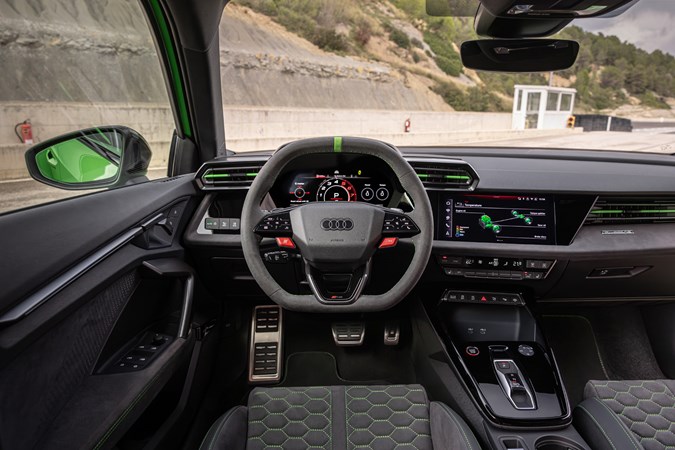
Sadly the main steering wheel buttons are tricky to use and feel quite cheap. Considering a standard A3 gets normal switchgear, it’s annoying that the RS3 uses these unintuitive buttons.
The RS3 generally works quite well as a small performance car but it’s not the most practical, with the boot in particular being quite small. Both the hatchback’s and saloon’s boots are around 100 litres smaller than a regular A3 – measuring 282 321 litres for the hatch and saloon respectively.
Comfort
You might think one of Audi’s sportiest models will fall short for comfort, but that’s not the case at all. There are three seating options available – the standard leather chairs with adjustable lumbar support and then electric leather seats that come with the top-spec Carbon Vorsprung.
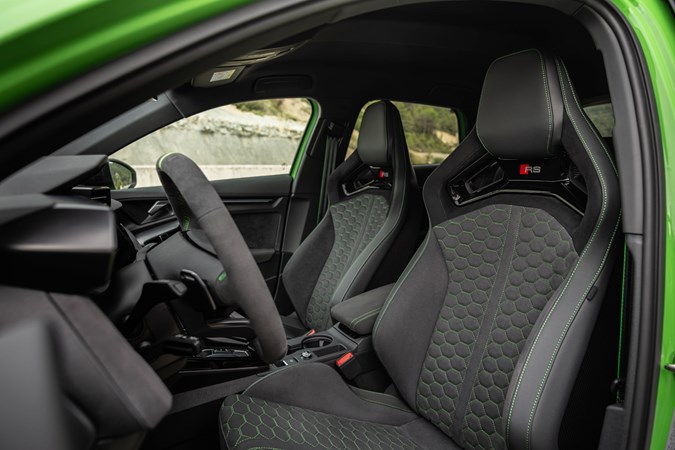
Above this you can also specify bucket seats for a £2,000 option. With a carbon-backed shell, they look quite aggressive but are actually very comfortable, with lots of support that makes them fine to spend hours behind the wheel in. It’s an option we’d choose if you want that sporty driving experience.
Safety
Though the RS3 might have twice the power of a standard A3, it’s fundamentally the same package and therefore shares that car’s five-star Euro NCAP safety rating. It’s not the most cutting-edge on the safety technology front, but we like the RS3 for having quick shortcut buttons to turn off sometimes-irritating features such as lane keep assist (you do this by pressing the side of the indicator stalk).
You can also choose an option pack incorporating adaptive cruise control, blind spot monitoring and rear cross-traffic alert for additional safety kit – or this is included with the top-spec Carbon Vorsprung trim level.
What engines are available?
The RS3’s main talking point is its engine – a 2.5-litre turbocharged petrol putting out 400hp and 500Nm of torque. It’s unique as it’s the only five-cylinder engine you can buy, and thanks to its firing order (the sequence in which the cylinders ignite in the combustion process), it produces an engine sound like no other car. It uses a seven-speed dual-clutch automatic gearbox as well as Audi’s usual quattro all-wheel-drive system.
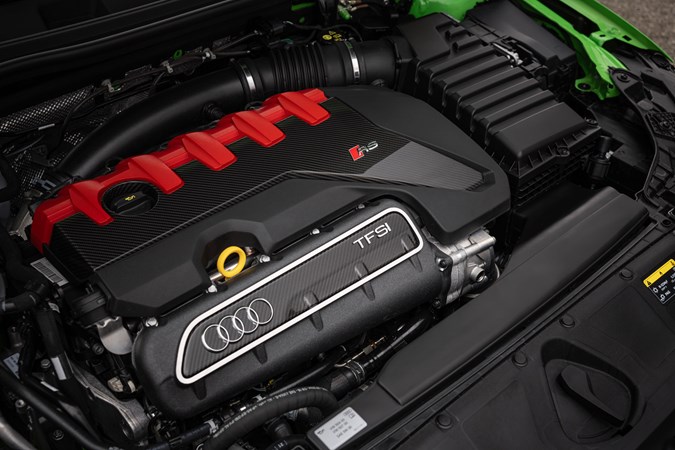
It’s not exactly lacking in performance – quite the opposite – with 0-62mph dispatched in just 3.8 seconds. The top speed is electronically limited to 155mph, but is raised to 174mph with the top-spec Carbon Vorsprung.
What’s it like to drive?
Aside from the engine, the key to the RS3’s magic has been its Torque Splitter. New for the RS3 is a Torque Splitter system at the rear axle, which replaces a conventional differential. Electronically controlled clutches at either side control how much torque is sent to each rear wheel. Ordinarily, more torque is pooled to the outside wheel, helping the RS 3 to turn more positively. In slippery conditions, if the system detects a slide at the rear, it can bundle torque to the inside wheel to help pull the car straight.
Audi has tweaked this further to allow even higher cornering speeds, enabling it to set a new lap record for a compact car around the famous Nurburgring Nordschleife circuit, shaving seven seconds off the previous car’s time, and all with no additional power. We tried the RS3 out around a tight racetrack near Barcelona and were astonished by the grip levels on offer – aided further by its track-focused Pirelli P Zero Trofeo tyres.
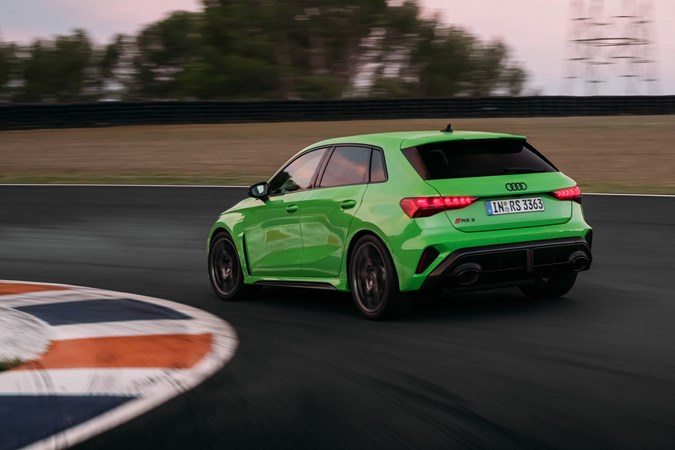
But it’s on the road where the RS3 comes into its own, with its ability to dispatch the performance in all conditions. The traction on offer from its four-wheel-drive system is impressive, and the point-to-point pace is superb. There’s the feeling you could keep up with plenty of high-end performance cars. The engine has a delightful warble and you can really hear the turbos doing their thing. It sounds like nothing else, and certainly makes the best noise of any hot hatch in this class.
One slight downside is the sheer number of driving modes available, with seven settings available and then on top of this the configurable RS Individual setting that lets you tailor your own driving mode. At least flicking between them is easily done by one of the big red steering wheel buttons.
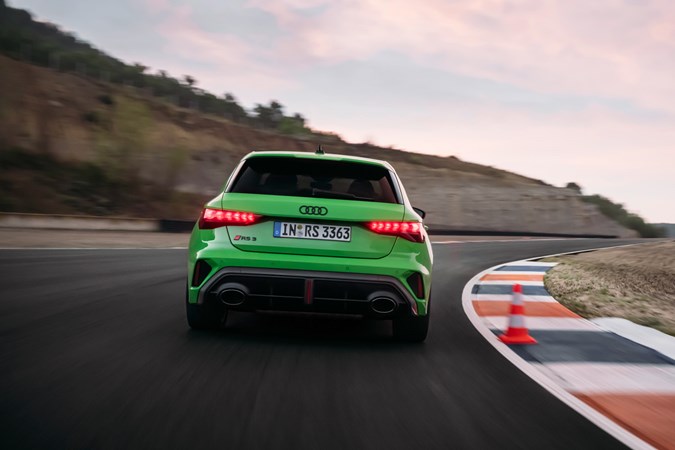
The steering has a pleasing amount of weight to it, and quickly inspires confidence to push on. The RS3’s limits are hard to find, though, given its seamlessly endless grip as only at the very upper limits does the smallest amount of understeer become apparent. Our RS3 test car was equipped with adaptive suspension, allowing you to soften or stiffen things up depending on your preference.
The ride quality is perhaps the biggest surprise with the RS3, as it’s particularly compliant, both on fast road driving but more impressively, even around town. It’s more comfortable than the standard A3 Saloon we run as a long-termer at Parkers, that is for sure, though we do need to try an RS3 on the standard suspension setup when it arrives in the UK for comparison.
Ownership costs and maintenance
While the Audi RS3 is expensive to buy, it has some impressive residual values owing to a long waiting list for new models and strong demand for used examples. This can make it a decent buy, but you do need to be aware that running and servicing costs will be more than rivals with a less complicated four-cylinder engine. Audi claims 30mpg and 209g/km CO2 emissions, too.
What models and trims are available?
Prices for the Audi RS3 start from £59,510 for the hatchback, and you’ll pay exactly £1,000 more to have it as a saloon, regardless of trim.
The standard car is relatively well-equipped with 19-inch alloy wheels, RS Sports suspension, a sports exhaust and Nappa leather upholstery. Other features include a Sonos sound system, head-up display and reversing camera.
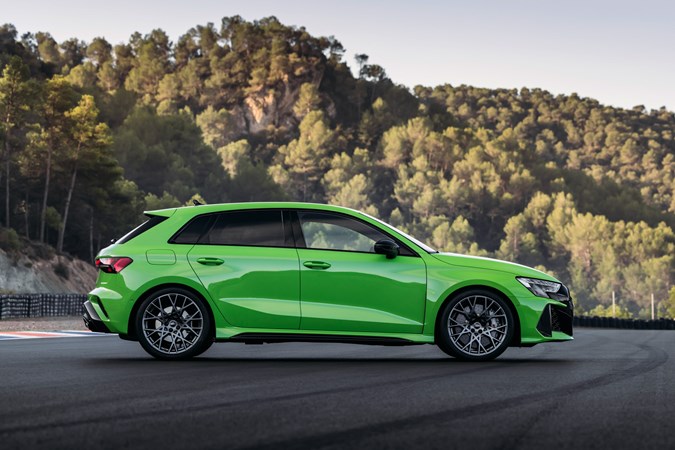
The Carbon Black trim brings a range of carbon styling details inside and out, as well as Matrix LED headlights, and starts from £64,160. The flagship Carbon Vorsprung starts from £68,650 and gains adaptive suspension, a panoramic sunroof, electric front seats and additional driver assistance technology.
Click through to our verdict to see if we think you should consider buying an Audi RS3. Find out more about how we test cars, on our detailed explainer page.


